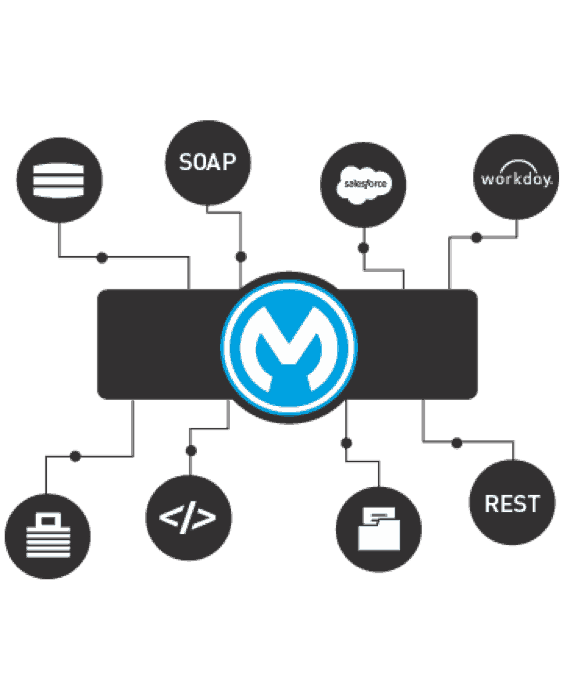An Enterprise Service Bus (ESB) is a set of principles and rules for connecting applications together over a bus-like infrastructure. ESB products enable users to build this architecture, but they differ in their methodology and the capabilities they provide. Mule as an ESB is the runtime engine of Anypoint Platform.
The core concepts of Mule ESB
The core concept of the ESB architecture is that applications are integrated by putting a communication bus between them and then enabling each application to talk to the bus. This allows systems to communicate without knowing about or depending upon other systems on the bus. The ESB emerged from the necessity of to moving away from point-to-point integration, which becomes brittle and hard to manage over time. Point-to-point integration, if left to proliferate, can’t be monitored easily and doesn’t scale because of the tight dependencies between applications.
One of the most common reasons why companies might choose to implement an ESB is to increase organizational agility. Companies might want to reduce the time to market for new initiatives or increase the number of applications being produced. An ESB architecture makes this happen by providing a simple, well defined, “pluggable” system that scales effectively. An ESB also provides a way to leverage your existing systems and expose them to new applications using its communication and transformation capabilities.

An ESB allows different applications to communicate with each other by carrying data between applications within your business or across the Internet. Mule as an ESB, in particular, has capabilities that include:
- Service creation and hosting — Mule as an ESB can expose and host reusable services using the ESB as a lightweight service container
- Service mediation — it can shield services from message formats and protocols, separate business logic from messaging, and enable location-independent service calls
- Message routing — Mule as an ESB routes, filters, aggregates, and re-sequences messages based on content and rules
- Data transformation — it exchanges data across numerous and varying formats and transport protocols
What are some other advantages of the Mule ESB?
- Lightweight — Mule as an ESB is the most lightweight integration platform available. The fully loaded distribution is 40 MB. It’s modular by design so you can remove unneeded modules to reduce its footprint. But being “lightweight isn’t just about size; it also encompasses the time, effort, and financial cost of making changes to existing integrations. The Mule runtime has modularization, fast deployment, and a configuration model that makes it simple to re-order, add, or change functionality.
- Doesn’t only provide mediation — many vendors think of an ESB as only a mediation engine between systems and therefore have separate products for hosting business logic and publishing services. This creates unnecessary complexity. Instead, the Mule runtime provides a light and scalable service container for publishing REST and SOAP services. And, since Mule integrates tightly with Spring, developers can also leverage the capabilities of Spring to implement business logic.
- Accessible — Mule as an ESB uses common tools that all Java developers are familiar with, like Maven, Eclipse, JUnit and Spring. It utilizes an XML configuration model (similar to Spring) to define logic. Custom code can be written in numerous languages, including Java, Groovy, JavaScript, Ruby or Python. In addition, Anypoint Studio helps new developers get up to speed quickly with a graphical development environment.
- Scales up and scales down — Mule as an ESB was designed for horizontal scale on commodity hardware. Mule’s runtime is easily embeddable into an application, and can also be embedded in your application server such as Tomcat, JBoss or WAS or directly in your application. Mule as an ESB also provides JUnit support so that it can be embedded in a JUnit test case. This is important because you can create repeatable unit tests for integrations that can run on a developer laptop and can be incorporated into a continuous build.
- Message agnostic — Mule as an ESB does not force XML messages on its users. While XML is commonly used, there are many scenarios where you will want to use JSON, flat files, Cobol Copybooks, binary and file attachments, streams, and Java objects. Mule streaming allows developers to process large messages efficiently.
- Can be deployed on-premises or in the cloud — there are numerous advantages to deploying your applications in the cloud, and there are advantages to deploying on-premise, or a hybrid of the two. Mule as an ESB can accommodate any of these approaches. And whether you are are deploying on-premise or the cloud or in a hybrid fashion, there are no new concepts to learn and the developer experience is identical.
Many organizations want to increase the clock speed of their business and increase organizational agility. ESBs promote this objective by implementing a simple, well defined, “pluggable” system that scales well. Mule as an ESB exists in a larger ecosystem of API design management capabilities, a library of out-of-the-box templates and connectors to speed reuse within your organization, and toolchains built for DevOps and agile software development methods. Mule as an ESB, the runtime engine of Anypoint Platform, offers extraordinary capabilities for an organization wanting to move faster and innovate more. Give Mule ESB a try!









